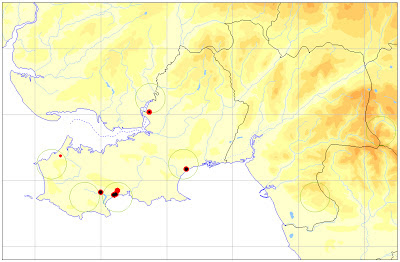The photographs of Yews (
Taxus baccata) in parish churches across Wales in Archie Miles’
Heritage Trees of Wales inspired Sandra and myself to brave the persistent wet weather and investigate the parish churches within Gower over the Christmas period. Of the 17 churchyards visited, 11 were found with Yew growing within the boundary walls. The largest specimen measured was at Llanrhidian, with a very respectable girth of 6.31m, though this would be a little less if the Ivy were to be removed. The second largest tree measuring in at 5.13m was at Ilston, where another 3.13m specimen also grows alongside Box with a basal girth of 2.61m. All other Yews measured were less than 5m.
The largest tree in each churchyard is ranked from largest to smallest below (apologies for the poor quality of the photos but it was dull and raining at almost every site!):
(1) 6.31m Llanrhidian (St. Illtyd & St. Rhidian’s Church)
.jpg) |
| Gower's Parish Champion Yew |
(2) 5.13m Ilston (St. Illtyd’s Church)
(3) 3.72m Nicholaston (St. Nicholas’s Church)
.jpg) |
| largest Yew just out of shot to the left |
(4) 3.68m Penmaen (St. John the Baptist's Church)
(5) 2.99m Bishopston (St.Teilo’s Church)
(6) 2.98m Reynoldston (St. George’s Church)
.jpg) |
the church has four Yews, one on each side of
the church, this being the largest by the entrance |
(7) 2.52m Oxwich (St. Illtyd’s Church)
(8) 1.45m Llangennith (St. Cenydd’s Church)
(9) 0.65m Oystermouth (All Saints Church)
.jpg) |
| fenced off and in poor health |
(10) 0.15m Pennard (St. Mary’s Church)
(11) 0.14m Cheriton (St. Cadoc’s Church)
.jpg) |
| the smallest Parish Yew! |
Parish Churches without Yews are:
Llanddewi (St. David’s Church)
Llanmadoc (St. Madoc’s Church)
Penclawdd (St. Gwynour’s Church)
Penrice (St. Andrew’s Church)
Port Eynon (St. Cattwg’s Church)
Rhossili (St. Mary’s Church)
It’s quite feasible of course that other large Yews grow elsewhere on the peninsula, for example there is a 4.01m Yew in the Mumbles British Legion car park, which currently qualifies as Gower’s third largest specimen. We know very little of parish churches away from the peninsula although there is some useful information on the Woodland Trust ‘Ancient Tree Hunt’ website which I would recommend exploring to those with an interest in veteran trees.
.jpg)
+31dec12+(1a).jpg)

.jpg)
.jpg)
.jpg)
.jpg)
.jpg)
.jpg)
.jpg)

.jpg)
.jpg)
.jpg)
.jpg)
.jpg)
.jpg)
.jpg)
.jpg)
.jpg)
.jpg)
.jpg)
+copy.jpg)
.jpg)

.jpg)






+10Dec12.jpg)
+10Dec12.jpg)
+06dec12+(1a).jpg)
+06dec12+(2sa).jpg)
+06dec12+(5a).jpg)







.jpg)
.jpg)



.jpg)
